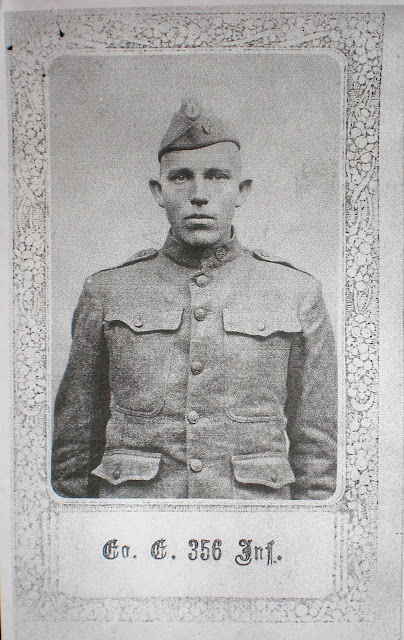Killed in Action: Private Arnold Henry Niederjohann
by Bob Brail
About 4,500 miles from New Melle, Missouri, is the St.
Mihiel American Cemetery near Thiaucourt, France. Its forty acres
cover the graves of over 4,000 Americans who died in World War One.
The cemetery is divided into four plots of equal size at the center
of which is a large sundial topped by an American eagle. In Row 8 of
Plot D is the grave of Private Arnold Henry Neiderjohann of New Melle
who was killed in action on September 23, 1918.
Niederjohann was born on Feb 3, 1895, to Henry and
Minnie Neiderjohann, who farmed near New Melle. When Neiderjohann
enlisted in the United States Army on June 5, 1917, he was unmarried
and working as a carpenter for a Foristell business. According to
his draft registration, Neiderjohann was of medium height and build,
and had gray eyes and black hair.
On
May 17, 1918, Neiderjohann, serial number 2,192,399, was assigned to
Company C, 356th
Infantry Regiment of the 89th
Division (Arch Bowman of Hamburg, who would be killed in action on
the next-to-the-last day of the war, was also in the 356th,
but in Company A). According to government documents, Neiderjohann
worked as a mechanic, although in letters to his parents Neiderjohann
wrote he served as a carpenter after his unit arrived in France on
June 4, 1918.
Neiderjohann's
regiment was eventually sent to the front near the small towns of
Dommartin, Charey, and Dampvitoux, an area about fifteen miles
southwest of Metz and 125 miles east of Paris. His regiment was
relieved on September 21 and began its movement away from the front.
However, the next day the 356th
received orders to return for an early morning raid on Dommartin
Woods the next day. Early in morning on September 23, a portion of
the 356th entered Dommartin Woods, advancing toward the German lines.
Their raid was successful, resulting in the capture of three
prisoners, partly due to the fact that the infantry had been
supported by Allied artillery. This artillery attack, though,
resulted in an enormous barrage of German artillery during the
regiment's retreat through the woods. As one historian wrote, “In
the darkness of the woods and heavy downpour of rain, the returning
troops lost their way, became separated, and suffered many
casualties.” Arnold Henry Neiderjohann was mortally wounded at
about 5:00 AM; there were no eyewitnesses. Neiderjohann was buried
in his uniform on the battlefield the next day.
Three weeks
later, on October 14, Henry and Minnie Neiderjohann were notified of
their son's death. However, in the following weeks, several men in
Company C had written the Neiderjohanns that their son had not been
killed, but only severely wounded. It is unclear as to why this
confusion existed, but these letters must have created false hopes
for the Neiderjohanns. However, in late December, Lt. Colonel
Charles Pierce wrote a letter to Henry and Minnie confirming their
son's death. In the middle of January, Henry Neiderjohann sent a
letter to Lt. Colonel Charles Pierce requesting information regarding
the death of their son and a photograph of his battlefield grave.
As
in the case of nearly every other American killed in action during
World War I, Neiderjohann's remains would be reinterred more than
once. The body was moved to St. Mihiel for reburial in April, 1919,
and then again disinterred on August 14, 1922, for reburial in the
St. Mihiel American Cemetery. Although Neiderjohann's remains could
have been removed yet again for transport to the United States for
reburial, his parents declined to take advantage of the government's
offer of repatriation. A short time later, in December, 1919, Minnie
Niederjohann died of heart disease.
Ten years
later, Congress created a second act meant to deal with the grief
caused by World War I. This Act of Congress was passed on March 2,
1929, and provided an opportunity for “the mothers and widows of
the deceased soldiers, sailors, and marines of the American forces
now interred in the cemeteries of Europe to make a pilgrimage to
those cemeteries.” The Act meant that the government would pay for
ship passage to France and a ten-day tour of the region, including a
visit to Paris and tours of battlefields for the mother or widow of
any American soldier who had died in Europe in World War I. By the
time the program concluded in 1933, over 5,000 women had taken the
trip at a cost to the government of over five million dollars.
Minnie
Niederjohann would not, of course, every take this trip. However,
the government apparently did not know of her death, because it sent
nine letters to New Melle from 1929 through 1933, asking if she
wanted to make a pilgrimage to her son's grave. Each time her
widowed husband Henry would indicate “NO” on the form and mail it
back to Washington, D. C. One can only try to imagine how these nine
letters, received ten to fifteen years after the deaths of his son
and wife, served as painful reminders of Henry Niederjohann's
enormous loss.
Little did Henry and Minnie Niederjohann know that when their son
left home to go off to war that they would never see him again. Like
thousands of other young American men, Arnold Henry Niederjohann died
for his country far away from this home and family. Killed in a
woods in eastern France, Niederjohann was eventually buried in the
American cemetery at St. Mihiel, a monument to America's commitment
to freedom.
Sources:
Fold3.com; “Gold Star Mothers” (rootsweb.ancestry.com);
Heritage.freese.net; “Pilgrimage for the Mothers and Widows . . .”
(Digital Library @ Villanova University); Regimental
History: 353rd Infantry
(kancoll.org/books/dienst/353-chap17);
St. Louis-Post Dispatch
(newspapers.com); “St. Mihiel American Cemetery” (abmc.gov);
“Soldiers' Records: War of 1812 – World War I” (s1.sos.mo.gov);
The World War with Company “A” 356th
Infantry 89th Division
(cdm.sos.mo.gov).
